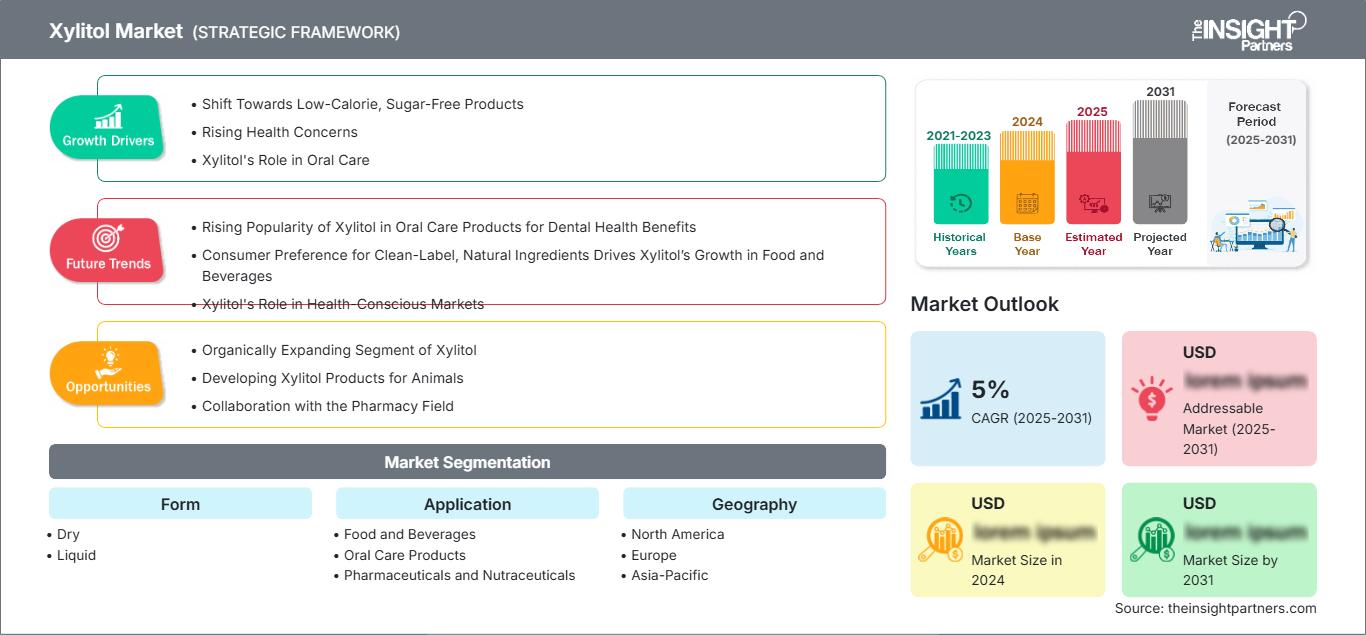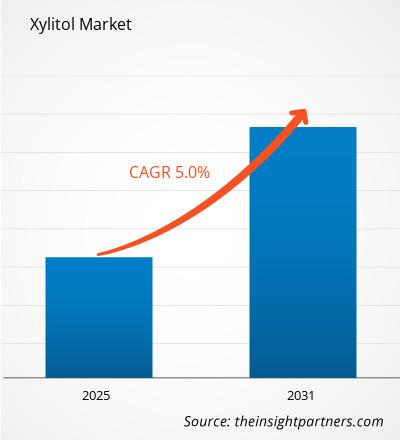Se espera que el mercado de xilitol registre una CAGR del 5% entre 2025 y 2031, con un tamaño de mercado que se expandirá de US$ XX millones en 2024 a US$ XX millones en 2031.
El informe está segmentado por formato (seco, líquido). Además, presenta un análisis basado en la aplicación [alimentos y bebidas (panadería y confitería, lácteos y postres congelados, bebidas, otros), productos para el cuidado bucal, productos farmacéuticos y nutracéuticos, cosméticos y artículos de tocador]. El análisis global se desglosa a nivel regional y por países principales. Geográficamente, el mercado se divide en América del Norte, Europa, Asia Pacífico, Oriente Medio y África, y América del Sur y Central. El informe ofrece el valor en USD para el análisis y los segmentos mencionados.
Propósito del Informe
El informe "Mercado del Xilitol" de The Insight Partners busca describir el panorama actual y el crecimiento futuro, los principales factores impulsores, los desafíos y las oportunidades. Esto proporcionará información a diversas partes interesadas del negocio, como:
- Proveedores/fabricantes de tecnología: Para comprender la dinámica cambiante del mercado y conocer las oportunidades potenciales de crecimiento, lo que les permitirá tomar decisiones estratégicas informadas.
- Inversores: Realizar un análisis exhaustivo de tendencias respecto a la tasa de crecimiento del mercado, las proyecciones financieras del mercado y las oportunidades que existen en toda la cadena de valor.
- Órganos reguladores: Regular las políticas y las actividades policiales en el mercado con el objetivo de minimizar el abuso, preservar la confianza de los inversores y defender la integridad y estabilidad del mercado.
Segmentación del mercado del xilitol
Forma
- Seco
- Líquido
Solicitud
- Alimentos y bebidas
- Productos para el cuidado bucal
- Productos farmacéuticos y nutracéuticos
- Cosméticos y artículos de tocador
Obtendrá personalización en cualquier informe, sin cargo, incluidas partes de este informe o análisis a nivel de país, paquete de datos de Excel, así como también grandes ofertas y descuentos para empresas emergentes y universidades.
Mercado del xilitol: perspectivas estratégicas

-
Obtenga las principales tendencias clave del mercado de este informe.Esta muestra GRATUITA incluirá análisis de datos, desde tendencias del mercado hasta estimaciones y pronósticos.
Factores que impulsan el crecimiento del mercado del xilitol
- Cambio hacia productos bajos en calorías y sin azúcar: La preferencia por productos sustitutivos bajos en calorías y sin azúcar está en aumento, lo que impulsa el consumo de xilitol. Cada vez más consumidores conocen sus beneficios, como bajos índices glucémicos, beneficios para la salud dental y beneficios para las personas con diabetes, lo que ha impulsado su uso en alimentos, bebidas y productos de cuidado personal.
- Preocupaciones crecientes por la salud: Ante el aumento de problemas mundiales como la obesidad y la diabetes, la tendencia hacia los sustitutos del azúcar es cada vez mayor. El xilitol es un edulcorante natural muy bajo en calorías y con un índice glucémico bajo; por lo tanto, resulta cómodo para la mayoría de los fabricantes de productos alimenticios sin azúcar y bajos en calorías, lo que se traduce en un mayor y mejor crecimiento del mercado.
- El papel del xilitol en el cuidado bucal: El xilitol es conocido por prevenir la caries dental y mejorar la salud bucal. Ahora que las personas son más conscientes de la higiene bucal, el xilitol se está incorporando a productos como pasta de dientes, chicles y enjuagues bucales; esto impulsa la demanda del mercado del cuidado bucal y amplía sus horizontes de mercado.
Tendencias futuras del mercado del xilitol
- Creciente popularidad del xilitol en productos de cuidado bucal por sus beneficios para la salud dental: La inclusión de xilitol en productos bucales como pasta de dientes, enjuague bucal y chicles se ha convertido en tendencia debido a sus beneficios dentales, como la prevención de caries y la reducción de la placa. A medida que más personas valoran la higiene bucal, cada vez más productos a base de xilitol para el cuidado dental.
- La preferencia del consumidor por ingredientes naturales y de etiqueta limpia impulsa el crecimiento del xilitol en alimentos y bebidas: Además, los consumidores ahora se inclinan por productos naturales y de etiqueta limpia al elegir un ingrediente como el xilitol en lugar de edulcorantes artificiales. Esto se evidencia en el creciente uso de xilitol en alimentos y bebidas de reciente introducción, así como en suplementos dietéticos, debido a la demanda de listas de ingredientes más saludables y claras.
- El papel del xilitol en los mercados que priorizan la salud: Tiene un bajo índice glucémico y es compatible con una dieta sin azúcar, lo que lo hace ideal para integrarlo en alimentos y bebidas funcionales. Cada vez más productos como caramelos sin azúcar, bebidas dietéticas y barras de proteínas utilizan xilitol como sustituto natural del azúcar, lo que promueve su crecimiento en los mercados que priorizan la salud.
Oportunidades de mercado del xilitol
- Segmento orgánico en expansión del xilitol: Esta creciente tendencia hacia los productos orgánicos y de etiqueta limpia ha resultado ser un gran impulso para los fabricantes de xilitol orgánico. Al introducir el xilitol orgánico en este segmento, las empresas pueden satisfacer la creciente demanda de alimentos, bebidas y productos de cuidado personal con ingredientes orgánicos, ofreciendo así una oferta atractiva para los consumidores preocupados por su salud.
- Desarrollo de productos de xilitol para animales: el xilitol está surgiendo entre los productos para el cuidado de mascotas, particularmente en formas de masticables dentales y golosinas dentales, y más allá de esos beneficios para proporcionar salud bucal a las mascotas, brinda a los dueños de mascotas la oportunidad de aumentar el mercado de xilitol para productos para mascotas, creando así ingresos adicionales para los fabricantes.
- Colaboración con el sector farmacéutico: La creciente demanda de edulcorantes bajos en calorías y sin índice glucémico en la industria farmacéutica representa una excelente oportunidad para el xilitol. Se pueden establecer colaboraciones con las compañías farmacéuticas involucradas en la fabricación de jarabes, comprimidos o cualquier otro producto sin azúcar o bajo en azúcar, dirigido a pacientes diabéticos y con otros trastornos metabólicos.
Perspectivas regionales del mercado del xilitol
Los analistas de The Insight Partners han explicado detalladamente las tendencias regionales y los factores que influyen en el mercado del xilitol durante el período de pronóstico. Esta sección también analiza los segmentos y la geografía del mercado del xilitol en América del Norte, Europa, Asia Pacífico, Oriente Medio y África, y América del Sur y Central.
Alcance del informe de mercado de xilitol
| Atributo del informe | Detalles |
|---|---|
| Tamaño del mercado en 2024 | US$ XX millones |
| Tamaño del mercado en 2031 | US$ XX millones |
| CAGR global (2025-2031) | 5% |
| Datos históricos | 2021-2023 |
| Período de pronóstico | 2025-2031 |
| Segmentos cubiertos |
Por formulario
|
| Regiones y países cubiertos |
América del norte
|
| Líderes del mercado y perfiles de empresas clave |
|
Densidad de actores del mercado del xilitol: comprensión de su impacto en la dinámica empresarial
El mercado del xilitol está creciendo rápidamente, impulsado por la creciente demanda del usuario final debido a factores como la evolución de las preferencias de los consumidores, los avances tecnológicos y un mayor conocimiento de los beneficios del producto. A medida que aumenta la demanda, las empresas amplían su oferta, innovan para satisfacer las necesidades de los consumidores y aprovechan las tendencias emergentes, lo que impulsa aún más el crecimiento del mercado.

- Obtenga una descripción general de los principales actores clave del mercado de xilitol
Puntos clave de venta
- Cobertura integral: el informe cubre de manera integral el análisis de productos, servicios, tipos y usuarios finales del mercado de xilitol, proporcionando un panorama holístico.
- Análisis de expertos: el informe se compila con base en el conocimiento profundo de expertos y analistas de la industria.
- Información actualizada: El informe asegura relevancia comercial debido a su cobertura de información reciente y tendencias de datos.
- Opciones de personalización: este informe se puede personalizar para satisfacer los requisitos específicos del cliente y adaptarse adecuadamente a las estrategias comerciales.
Por lo tanto, el informe de investigación sobre el mercado del xilitol puede ayudar a descifrar y comprender el panorama de la industria y sus perspectivas de crecimiento. Si bien existen algunas preocupaciones válidas, las ventajas generales de este informe suelen superar las desventajas.
- Análisis histórico (2 años), año base, pronóstico (7 años) con CAGR
- Análisis PEST y FODA
- Tamaño del mercado, valor/volumen: global, regional y nacional
- Industria y panorama competitivo
- Conjunto de datos de Excel
Informes recientes
Testimonios
Razón para comprar
- Toma de decisiones informada
- Comprensión de la dinámica del mercado
- Análisis competitivo
- Información sobre clientes
- Pronósticos del mercado
- Mitigación de riesgos
- Planificación estratégica
- Justificación de la inversión
- Identificación de mercados emergentes
- Mejora de las estrategias de marketing
- Impulso de la eficiencia operativa
- Alineación con las tendencias regulatorias






















 Obtenga una muestra gratuita para - Mercado del xilitol
Obtenga una muestra gratuita para - Mercado del xilitol